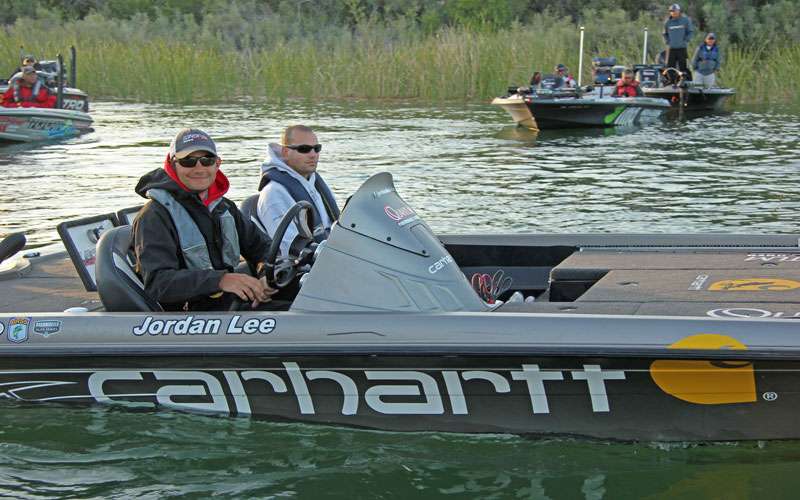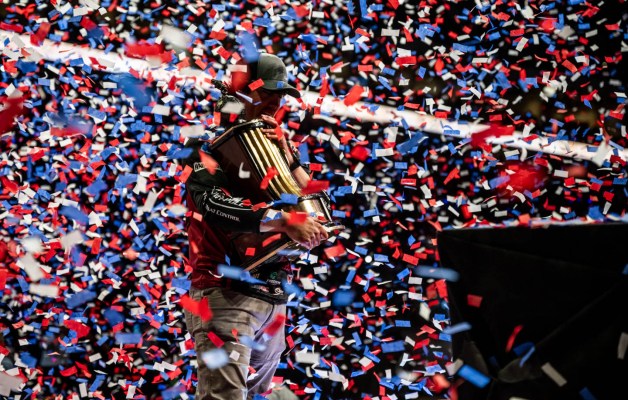
Hamilton Carhartt probably never envisioned his name on a sleek boat flying across a body of water at 70 mph, nor on the clothing of folks casting for fish they’ll catch, weigh and release in competition.
When he began his clothing business with two sewing machines and five workers in 1889, Carhartt was focused on outfitting rail yard workers with garments that would last. What transpired over the next 125 years is an American success story. Last year, more than 2,000 employees worked to make 7 million garments in Carhartt’s four American factories.
It all began with those railroad workers, moved to construction sites, the farm, hunters, and now is full-steam ahead on the water. Several years ago, Carhartt teamed with B.A.S.S. in what they think is a perfect fit for both.
Fishing and hunting
“From a marketing perspective, you always go to great places to tell your story,” said Tim Humes, Carhartt’s senior brand manager of sponsorships and entertainment marketing. “We know overwhelmingly that our core consumers love to fish and hunt and be in the outdoors. We were looking for opportunities to inform consumers of new products.”
So to reach those with a passion for the fishing lifestyle, Carhartt cast its lines with B.A.S.S. Carhartt became its official apparel sponsor and is the supporting sponsor of the Bassmaster Classic, the Elite and Opens series.
With an eye to the future, Carhartt became title sponsor of the Collegiate Series, which crowns a national champion then sends the top angler to the Bassmaster Classic. They’ll do it again July 9-14 at the Carhartt Bassmaster College Series National Championship presented by Bass Pro Shops on Lake DuBay in Stevens Point, Wis. One team will take home the trophy as national champion and one angler will qualify for the 2016 Classic.
“B.A.S.S. is the gold standard for fishing organizations,” Humes said. “I can never say enough good things about Jerry McKinnis and what a pioneer and leader he is in the industry. For us to collaborate with Jerry and B.A.S.S. made all the sense in the world, for two very credible brands to come together and tell stories.”
McKinnis and Carhartt have similar stories. Both saw an opportunity and built on it. McKinnis launched his successful TV career from a chance meeting at a boat dock, which he details in his recently published book, Bass Fishing, Brown Dogs & Curveballs.
Hamilton Carhartt’s history
Carhartt started a wholesale furniture company but had interests in the clothing business. He saw a niche to fill when he visited the Detroit rail yard to pick up supplies and noticed workers in tattered clothes.
“The idea struck that he could make something better for these guys, so he set out to make a better coverall and bib overall,” Humes said.
Failing at first, Carhartt conferred with a rail worker and made a garment to his specs out of duck, a tightly woven cotton fabric used to make tents and ship sails. It wasn’t long before those Detroit workers, wearing their durable, triple-stitched duds, had admirers in Chicago and other stops.
“It was truly a word of mouth beginning for Carhartt,” Humes said. “And Hamilton stuck to it and really believed in building rugged, durable and good fitting products for men and women in the hard work trades.”
By 1910, Carhartt, who had added a second ‘t’ in naming his products to stand out, had mills in the southeast and sewing facilities across America and Canada. After a foray into building cars was short-lived, Carhartt again focused on growing what would become an iconic clothing line. His seven facilities were there to churn out U.S. military uniforms for World War I and later denim and women’s work wear during WWII.
It wasn’t long after The Great War that the legendary Carhartt Chore Coat was introduced, and it hasn’t changed much in the past 92 years. The Great Depression nearly did in the company, but Carhartt survived. In 1932, it introduced the rugged Double-Front Work Dungaree that remains a staple of workers today.
“Our traditional brown fabric wears like iron, but breaks in very nice,” Humes said. “I think when he came up with triple stitching, as well as how some of the seams were finished, it really did lead to a durability story.”
Those stories include Carhartt clothing stopping a .22 bullet from penetrating a man and a toddler being unharmed after being mauled by a dog. At its Detroit headquarters, Carhartt showcases some ancient clothing from customers.
“They wear our apparel for years and they don’t know what to do with it,” Humes said. “Some send it back with stitched up holes, duct-taped arms. This is stuff from 30, 40 years ago.”
Hamilton’s motto was “Honest value for an honest dollar,” and his ancestors took that to heart.
“We’re now in our 126th year, which is pretty amazing,” Humes said. “It’s still a family owned company. The fourth generation, the great, great grandson of Hamilton Carhartt, still runs the company.”
New technologies
That would be Mark Valade, who became president in 1996 and took the company into the European market and Internet operations. He’s launched retail stores, women’s lines and introduced the latest developments in fabrics.
“With some of our new technologies, it has given guys more opportunity to have their favorite brand out with them on the water,” said Humes, who added the Force line is popular among anglers. “It’s got a fast-dry technology. It wicks sweat. It’s anti-odor – we know fishermen are super smelly. It’s kind of that technical fabric you see in some sports brands.”
The Storm Defender and Rain Defender lines are others that anglers appreciate as they can stand up to those cold launches as well as rain showers.
“I think what they’re finding is, because we design for movement and durability, it gives them everything they need out on the water,” Humes said. “In rain, cold and wind, they don’t stop fishing.”
Elites in action
To see Carhartt in action on the Elite Series, go no further than rookies Matt and Jordan Lee. Carhartt sponsors both, its gold, swooshing C logo adorning wraps on the brothers’ boats and trucks, as well as their clothes.
The Lee Brothers excelled for Auburn University in College B.A.S.S. events, each earning trips to Bassmaster Classics. Matt went to the 2013 Classic after an emotional victory over Jordan, who qualified the next year and finished sixth in the Classic on Guntersville, their home lake. Both fished Bassmaster Opens to earn Elite invitations, and Carhartt couldn’t be happier with their choices.
“We were so fortunate to have these two young men be champions that led us out there on our launch with this program, we decided to keep them on board as Carhartt anglers,” Humes said. “They’re bright, intelligent, well-spoken and just hardcore fisherman. They do a great job. To have some anglers on board really helps tell our story.”
The Lees, along with veteran Elite angler Terry Scroggins, get the name out at bass competitions as well as fishing shows. They even make appearances at some of Carhartt’s 17 retail stores. Matt Lee recently took his rig to New York’s Central Park for a Casting Kids event.
The Carhartt College Series, which Humes wished was around when he went to college, has grown more than twofold since its inception. They are now more than 500 schools with teams, and Carhartt is dedicated to help the anglers get to the next level of their career.
“I love the passion that these kids have about the sport,” Humes said. “They are the future of the sport. B.A.S.S. has done a great job putting support behind it, giving these young men and women a chance to compete.
“How awesome is it to give college kids a chance to go to the Classic and learn what that’s like? We’re a really proud supporter of that College series and we hope to help B.A.S.S. grow it.”





